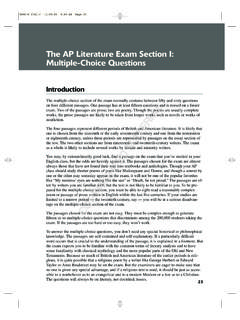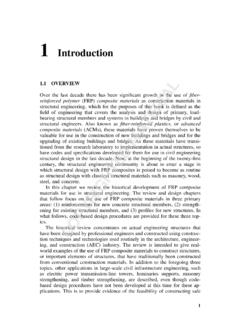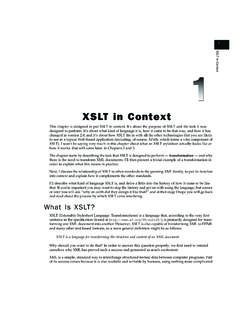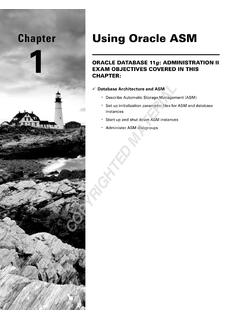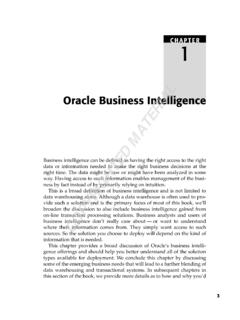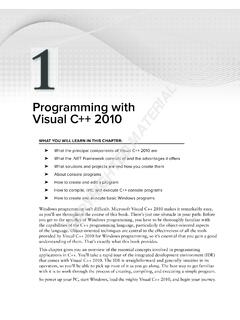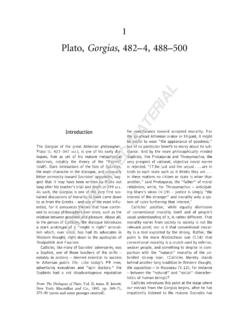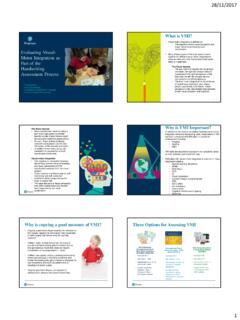Transcription of MILLON CLINICAL MULTIAXIAL INVENTORY–III …
1 INTRODUCTIONThe MILLON CLINICAL MULTIAXIAL Inventory III (MCMI- III; MILLON , 2006) is a 175- item True / False self- report measure of 14 personality patterns and 10 clini -cal syndromes for use with adults 18 years of age and older who are being evaluated and / or treated in mental health settings. Since the introduction of this test in 1977, it has become one of the most frequently used assessment instruments for the examination of personality disorders and major CLINICAL syndromes. Only the Rorschach and MMPI- 2 have produced more research within the past 5 years. There are now over 700 empirical studies based on this measure (Craig, 1993a, 1997) and eight books (Craig, 1993a, b; Craig, 2005a, b; Choca 2004; Jankowski, 2002; McCann & Dyer, 1996; Retzlaff, 1995). The test is now routinely included in texts that present chapters on major psychological AND DEVELOPMENTThe original version of this instru-ment, the MCMI- I ( MILLON , 1983a), was developed to operationalize the theory of psychopathology in-troduced by MILLON (1969 / 1983b) in Modern Psychopatholog y.
2 In that text he proposed three axes ac-tive passive, pleasure pain, self 1 OneMILLON CLINICAL MULTIAXIAL INVENTORY IIIR obert J. CraigDON T FORGET The MCMI- III is appropriate for use with adults who are being evaluated and / or treated in men-tal health settings. It was designed to detect per-sonality disorders and a few clini -cal syndromes. It should not be used with per-sons who are not seeking mental health assistance ( , normal individuals).COPYRIGHTED MATERIAL 2 ESSENTIALS OF MILLON INVENTORIES ASSESSMENT other as the basic building blocks of normal and abnormal personality. Conceived in terms of instrumental coping patterns designed to maximize positive reinforcements and avoid punishment, the model crossed the active passive axis with four reinforcement strategies detached, dependent, inde-pendent, and ambivalent to derive eight basic personality patterns (asocial, avoidant, submissive, gregarious, narcissistic, aggressive, conforming, neg-ativistic) and three severe variants (schizoid, cycloid, paranoid).
3 Although MILLON did not propose a formal model of CLINICAL syndromes along with his personality taxonomy, he asserted that most or all psychiatric conditions ( , major depression, anxiety disorders, psychosis) could be best explained as extensions of s strong theoretical interests led him to a test- development strategy that was also grounded in theory. Jane Loevinger (1957) had previously pro-posed that assessment instruments be built in a three- step process with theory guiding development and validation in every step. MILLON used her strategy to create the MCMI- I as well as subsequent editions of the three steps of test development and validation described by Loevinger (1957) were called theoretical- substantive, internal- structural, and external. In the theoretical- substantial phase, items are generated for scales in terms of how well they conform to theory. Here MILLON created an initial pool of face- valid items and then split the 1,100- item list into two equivalent the internal- structural phase of development, scales are created to match a set of criteria defi ned by the theory.
4 For example, MILLON s (2006; MILLON & Davis, 1996) model posits that personality scales should have high internal consistency, test- retest reliability, and a theoretically consistent pat-tern of correlations with other scales. During this phase, the two test forms were administered to a variety of CLINICAL samples and MILLON retained items with the highest item- total scale correlations. He then calculated item- scale intercorrelations and item endorsement frequencies and eliminated items with extreme endorsement frequencies ( , < 15% and > 85%). This left 440 items, which were later reduced to 289. MILLON gave the experimental form of the MCMI- I to a variety of CLINICAL patients and had 167 clinicians complete a diagnostic form for each patient they had seen for assessment or therapy. The items were then reduced to 150. Three experimental scales were eliminated and three scales were added and the validation process MILLON CLINICAL MULTIAXIAL INVENTORY- III 3previously described was then repeated until the fi nal version contained 175 it e m the third stage of external criterion validation, which is analogous to convergent- discriminant validity, MILLON had psychiatric patients complete the fi nal form of the MCMI- I along with several self- report measures of per-son a l it y a nd c l i n ica l sy nd romes.
5 Based on t hese d at a he jud g ed t h at t he sca les were faithful to his theory and the test was then published with norms based on over 1,500 psychiatric second edition of the measure, the MCMI- II ( MILLON , 1987), was cre-ated to keep pace with changes in the revised 3rd edition of the Diagnostic and Statistical Manual of Mental Disorders- III- R (DSM- III- R; American Psychiatric Association [APA], 1987). An experimental form was developed according to the model previously described totaling 368 items. Scales measuring Self- Defeating and Aggressive- Sadistic personality disorders were developed. A total of 45 items in the MCMI- I were changed and MILLON introduced an item- weighting system whereby prototype items ( , those items essentially related to the disorder) were given higher scores. He also derived three valid-ity scales and increased the number of personality disorder scales from 11 to 13.
6 Validation studies were then conducted as described MCMI- III was developed to bring the test in line with DSM- IV (APA, 1994; see Rapid Reference ). Here, 45 of the 175 items in the MCMI- II were changed, two new personality disorder scales were added to the test (depressive personality disorder and posttraumatic stress disorder), the item- weighting system was changed from a three- point to a two- point system, scales were reduced in length, and noteworthy items pertaining to child abuse and eating disorders were added but not scored on any of the scales. Sig-nifi cant ly, M i l lon made sure t hat most test items d irect ly refl ected diagnostic criteria in the DSM- IV. The published version of the MCMI- III contains a three- item Validity index, three Modifi er Indices to assess response bias, 14 personality scales, and 10 CLINICAL syndrome scales.
7 The personality and CLINICAL scales contain 12 to 24 items each. Internal consistency of the scales was estimated to be between .67 and .90 using Cronbach s (1951) alpha, and test- retest stability was estimated to be between .84 and .96 over a period of 5 to 14 days ( MILLON , 2006, p. 76). Rapid Reference summarizes the MCMI- III scales. 4 ESSENTIALS OF MILLON INVENTORIES ASSESSMENTItem Overlap and Item WeightingA notable feature of MILLON s (2006; MILLON & Davis, 1996) model of psy-chopathology is that various personality types and CLINICAL syndromes are presumed to be related to one another in a predictable manner. For example, schizoid and avoidant personality styles are believed to share a trait of social detachment. This trait makes both types of individuals appear distant, with-drawn, and uneasy in social situations. In decompensated form, these per-sonalities are thought to be prone to schizotypal and psychotic accordance with his model, theoretically related personality and CLINICAL scales share certain items.
8 The number of shared items varies across the test, but MILLON (2006) identifi ed the most defi ning characteristics of a scale by assigning a weight of 2 to these primary, or prototypical items, and giving a smaller weight of 1 to items that are less defi nitive, or nonprototypical. Thus, the central features of a personality style or CLINICAL syndrome are weighted 2, while characteristics that are less central and defi n i ng a re weighted 1. Ca ref u l MILLON CLINICAL MULTIAXIAL Inventory- IIIA uthor: Theodore MILLON Date: 1994 What the test measures: Personality disorders and CLINICAL syndromesAge Range: 18 and aboveAdministration Time: 20 30 minutesQualifi cation of examiners: Graduate training in psychodiagnostic as-sessment. Users of interpretive repor ts must meet full membership quali-fi cations for the American Psychological Association, American Psychiatric Association, American Medical Association, or the National Association of Social : Pearson Assessments5601 Green Valley DriveBloomington, Mn 55437- 118 7 Phone: 800- 627- 7271 Fax: 800- 632- 9011 MCMI- III manual, $50; profi le report $15 ; interpretive report, $ (2007 prices).
9 Rapid Reference MILLON CLINICAL MULTIAXIAL INVENTORY- III 5 Summary of MCMI- III ScalesValidity IndexTwo items measure highly improbable events designed to detect random responding and IndexesX. Disclosure. Scale X measures the amount of self- disclosure and willing-ness to admit to symptoms and Desirabilit y. Scale Y measures examinee s tendency to answer items that make one look very favorable and without Debasement. Scale Z assesses examinee s tendency to answer items by accentuating, highlighting, and exaggerating problems and Personality Pattern Scales1. Schizoid. Individuals are socially detached; prefer solitary activities; seem aloof, apathetic, and distant with diffi culties in forming and maintaining Avoidant. Individuals are socially anxious due to perceive expectations of Depressive. Individuals are downcast and gloomy, even in the absence of a CLINICAL Dependent. Individuals are passive, submissive, and feel inadequate.
10 They generally lack autonomy and Histrionic. Individuals are gregarious, with a strong need to be at the cen-ter of attention. They can be highly Narcissistic. Individuals are self- centered, exploitive, arrogant, and Antisocial. Individuals are irresponsible, vengeful, engage in criminal be-havior, and are strongly Aggressive (Sadistic). Individuals are controlling and abusive; they enjoy humiliating Compulsive. Individuals are orderly, organized, effi cient, and perfection-istic. They engage in these behaviors to avoid chastisement from Passive- Aggressive (Negativistic). Individuals are disgruntled, argumen-tative, petulant, oppositional, negativistic; they keep others on Reference (continued) 6 ESSENTIALS OF MILLON INVENTORIES ASSESSMENT8B. Self- Defeating. Individuals seem to engage in behaviors that result in people taking advantage of and abusing them. They act like a martyr and are self- sacrifi cing.
